2005 BMW X5 air condition
[x] Cancel search: air conditionPage 20 of 48
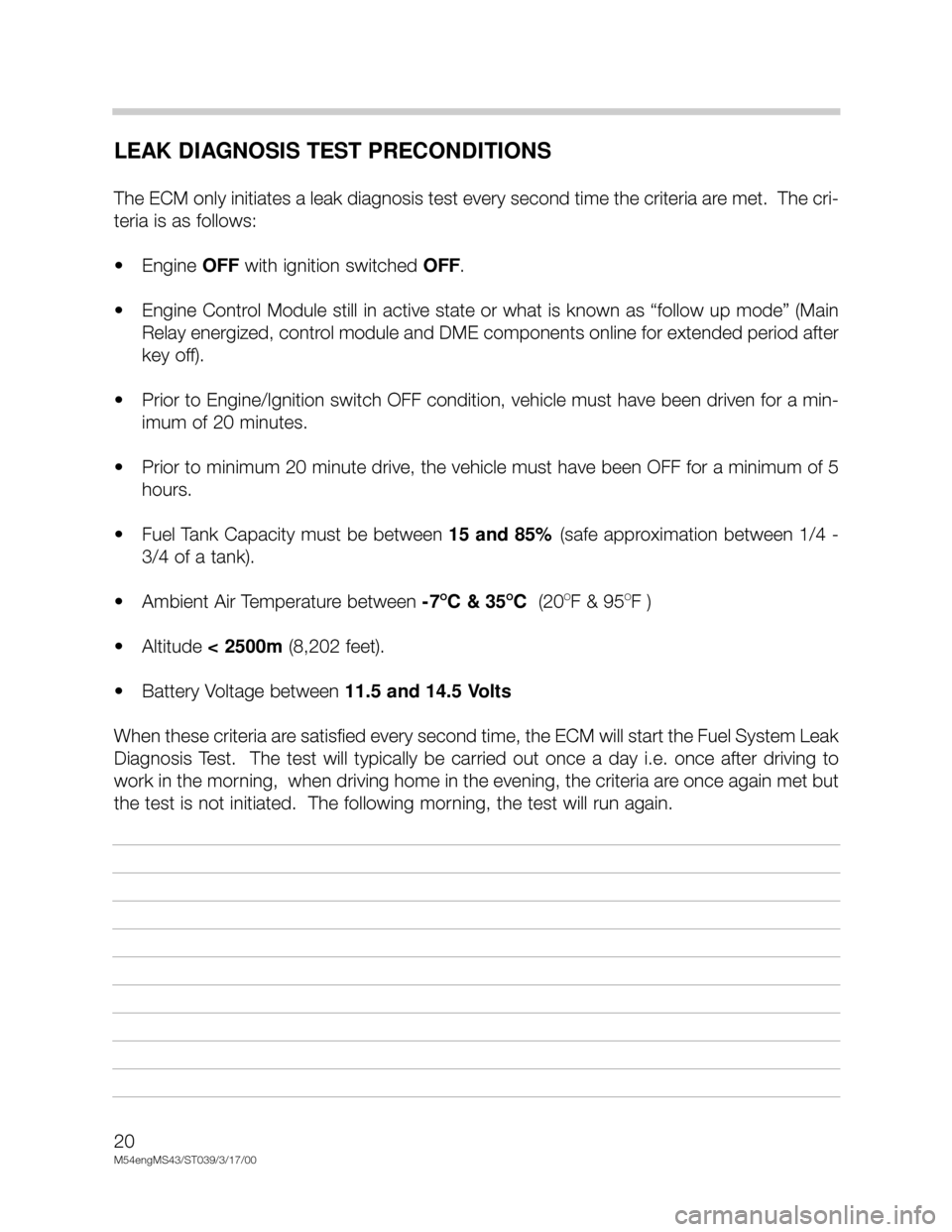
20
M54engMS43/ST039/3/17/00
LEAK DIAGNOSIS TEST PRECONDITIONS
The ECM only initiates a leak diagnosis test every second time the criteria are met. The cri-
teria is as follows:
• Engine OFF with ignition switched OFF.
• Engine Control Module still in active state or what is known as “follow up mode” (Main
Relay energized, control module and DME components online for extended period after
key off).
• Prior to Engine/Ignition switch OFF condition, vehicle must have been driven for a min-
imum of 20 minutes.
• Prior to minimum 20 minute drive, the vehicle must have been OFF for a minimum of 5
hours.
• Fuel Tank Capacity must be between 15 and 85%(safe approximation between 1/4 -
3/4 of a tank).
• Ambient Air Temperature between -7
OC & 35OC(20OF & 95OF )
• Altitude < 2500m(8,202 feet).
• Battery Voltage between 11.5 and 14.5 Volts
When these criteria are satisfied every second time, the ECM will start the Fuel System Leak
Diagnosis Test. The test will typically be carried out once a day i.e. once after driving to
work in the morning, when driving home in the evening, the criteria are once again met but
the test is not initiated. The following morning, the test will run again.
Page 25 of 48

25
M54engMS43/ST036/6/20000
OXYGEN SENSOR SIGNAL INFLUENCE ON INJECTOR “OPEN” TIME
The ECM monitors the:
• Amplitude of the signal (highest voltage or range sensor is producing)
• Switching time of the signal (how fast from lean to rich)
• Frequency of complete cycles (how many within a period of time)
These characteristics provide info to the ECM that reflect the overall condition of the sen-
sor.
POST CATALYTIC CONVERTER SENSOR SIGNAL
The post catalyst O2 sensors monitor the efficiency of the catalyst as a requirement of OBD
II. This signal also provides feedback of the pre-catalyst sensors efficiency and can cause
the ECM to “trim” the ms injection time to correct for slight deviations.
• If the catalyst is operating efficiently, most of the remaining oxygen in the exhaust gas
is burned (lack of O2 - “constant lean signal”).
The sensor signal fluctuates slightly in the higher end of the voltage scale.
• If the post sensor shows excessive fluctuations
(which echo the scope pattern of the pre
sensor), this indicates that the catalytic converter is not functioning correctly and cannot
consume the O2 (fault set).
• If the post sensor fluctuations move out of the normal voltage “window”, this indicates
that the pre sensor is not performing properly due toslight
deterioration. These systems
can also “trim” the ms injection time to compensate for this.
The constantly changing oxygen sensor input to the ECM is needed to correct the ms
injection time to ensure that the ideal air/fuel ratio is maintained.
Page 36 of 48
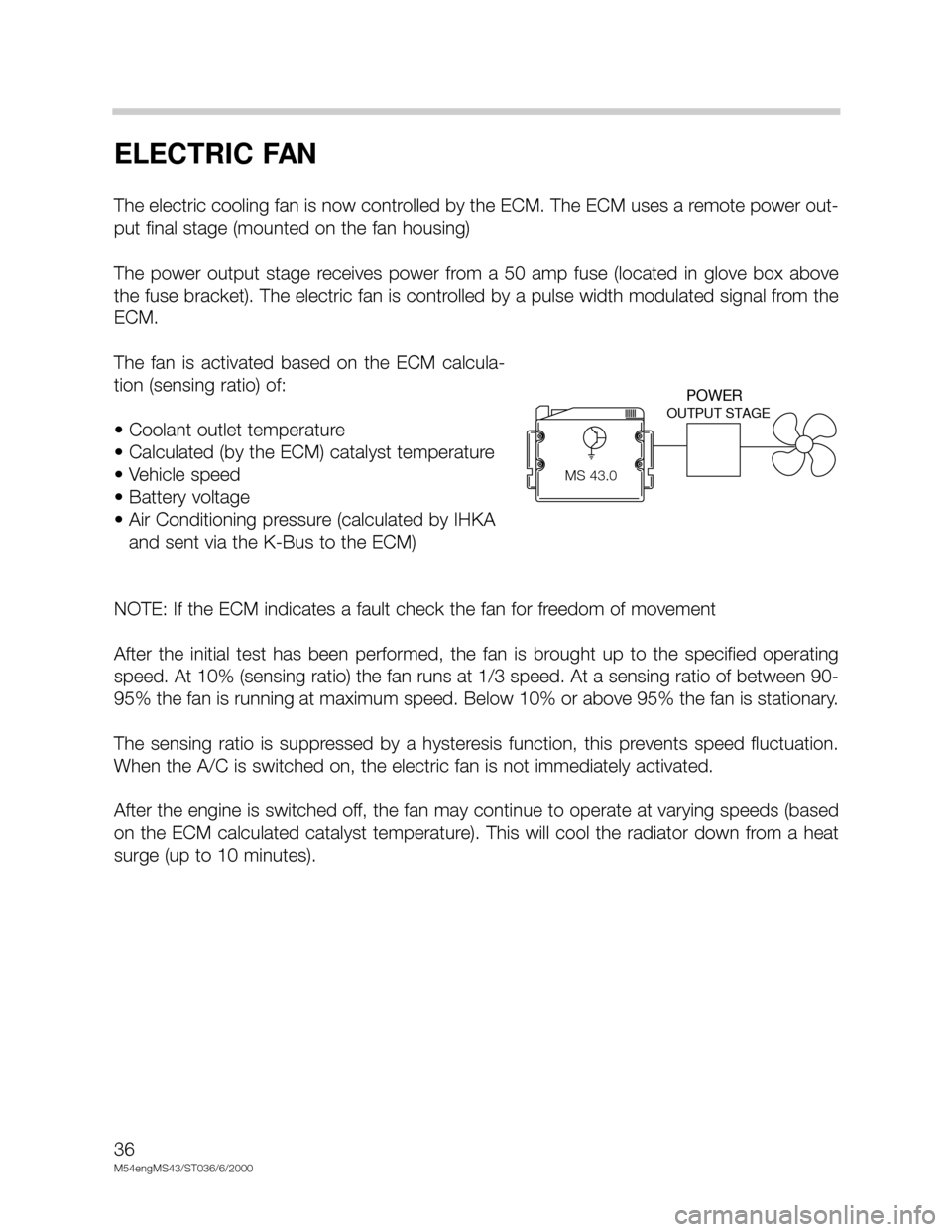
36
M54engMS43/ST036/6/2000
ELECTRIC FAN
The electric cooling fan is now controlled by the ECM. The ECM uses a remote power out-
put final stage (mounted on the fan housing)
The power output stage receives power from a 50 amp fuse (located in glove box above
the fuse bracket). The electric fan is controlled by a pulse width modulated signal from the
ECM.
The fan is activated based on the ECM calcula-
tion (sensing ratio) of:
• Coolant outlet temperature
• Calculated (by the ECM) catalyst temperature
• Vehicle speed
• Battery voltage
• Air Conditioning pressure (calculated by IHKA
and sent via the K-Bus to the ECM)
NOTE: If the ECM indicates a fault check the fan for freedom of movement
After the initial test has been performed, the fan is brought up to the specified operating
speed. At 10% (sensing ratio) the fan runs at 1/3 speed. At a sensing ratio of between 90-
95% the fan is running at maximum speed. Below 10% or above 95% the fan is stationary.
The sensing ratio is suppressed by a hysteresis function, this prevents speed fluctuation.
When the A/C is switched on, the electric fan is not immediately activated.
After the engine is switched off, the fan may continue to operate at varying speeds (based
on the ECM calculated catalyst temperature). This will cool the radiator down from a heat
surge (up to 10 minutes).
OUTPUT STAGE
MS42.0
POWER
MS 43.0
Page 37 of 48
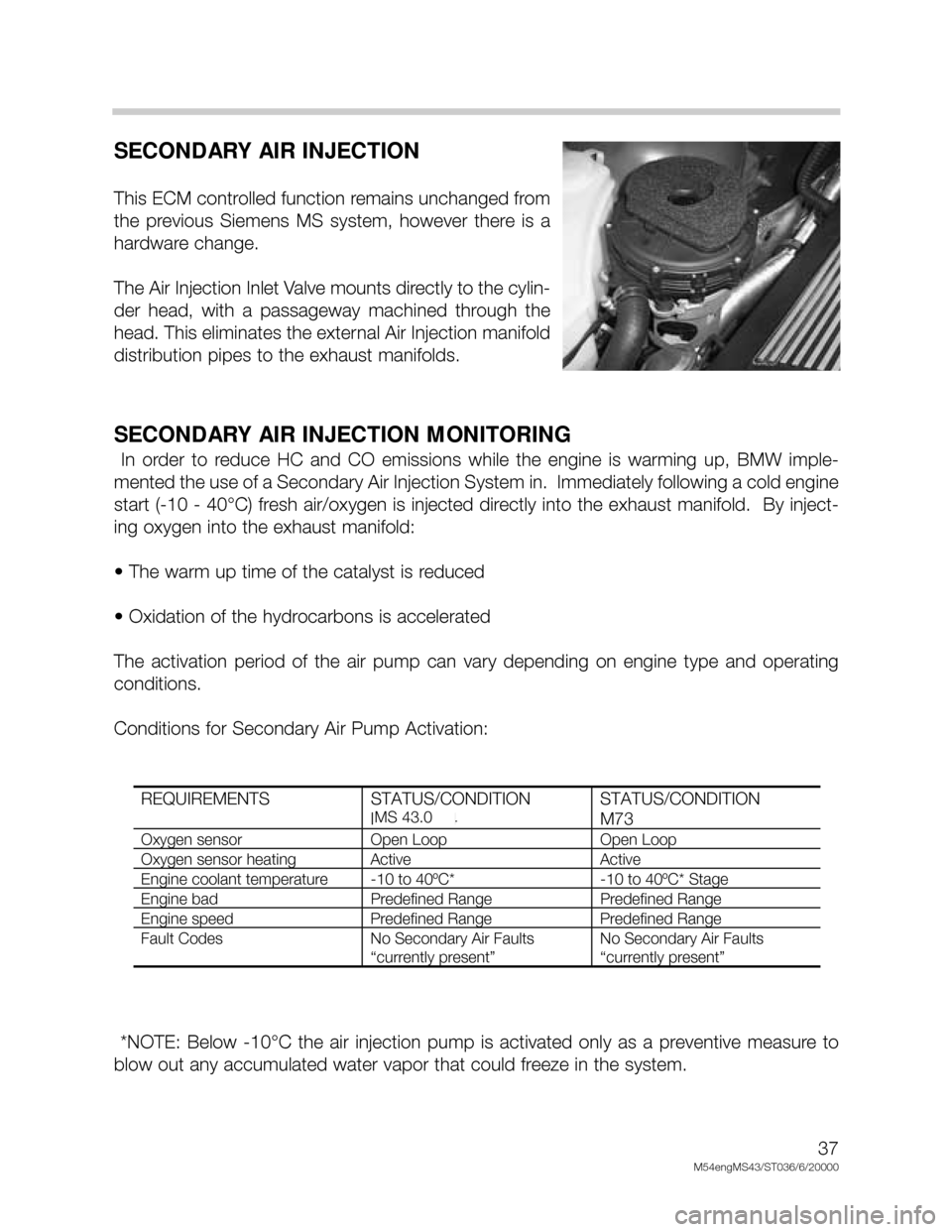
37
M54engMS43/ST036/6/20000
SECONDARY AIR INJECTION
This ECM controlled function remains unchanged from
the previous Siemens MS system, however there is a
hardware change.
The Air Injection Inlet Valve mounts directly to the cylin-
der head, with a passageway machined through the
head. This eliminates the external Air Injection manifold
distribution pipes to the exhaust manifolds.
SECONDARY AIR INJECTION MONITORING
In order to reduce HC and CO emissions while the engine is warming up, BMW imple-
mented the use of a Secondary Air Injection System in. Immediately following a cold engine
start (-10 - 40°C) fresh air/oxygen is injected directly into the exhaust manifold. By inject-
ing oxygen into the exhaust manifold:
• The warm up time of the catalyst is reduced
• Oxidation of the hydrocarbons is accelerated
The activation period of the air pump can vary depending on engine type and operating
conditions.
Conditions for Secondary Air Pump Activation:
*NOTE: Below -10°C the air injection pump is activated only as a preventive measure to
blow out any accumulated water vapor that could freeze in the system.
REQUIREMENTS STATUS/CONDITION
M52 & M44STATUS/CONDITION
M73
Oxygen sensor Open Loop Open Loop
Oxygen sensor heating Active Active
Engine coolant temperature -10 to 40ºC* -10 to 40ºC* Stage
Engine bad Predefined Range Predefined Range
Engine speed Predefined Range Predefined Range
Fault Codes No Secondary Air Faults
“currently present”
No Secondary Air Faults
“currently present”
MS 43.0
Page 38 of 48
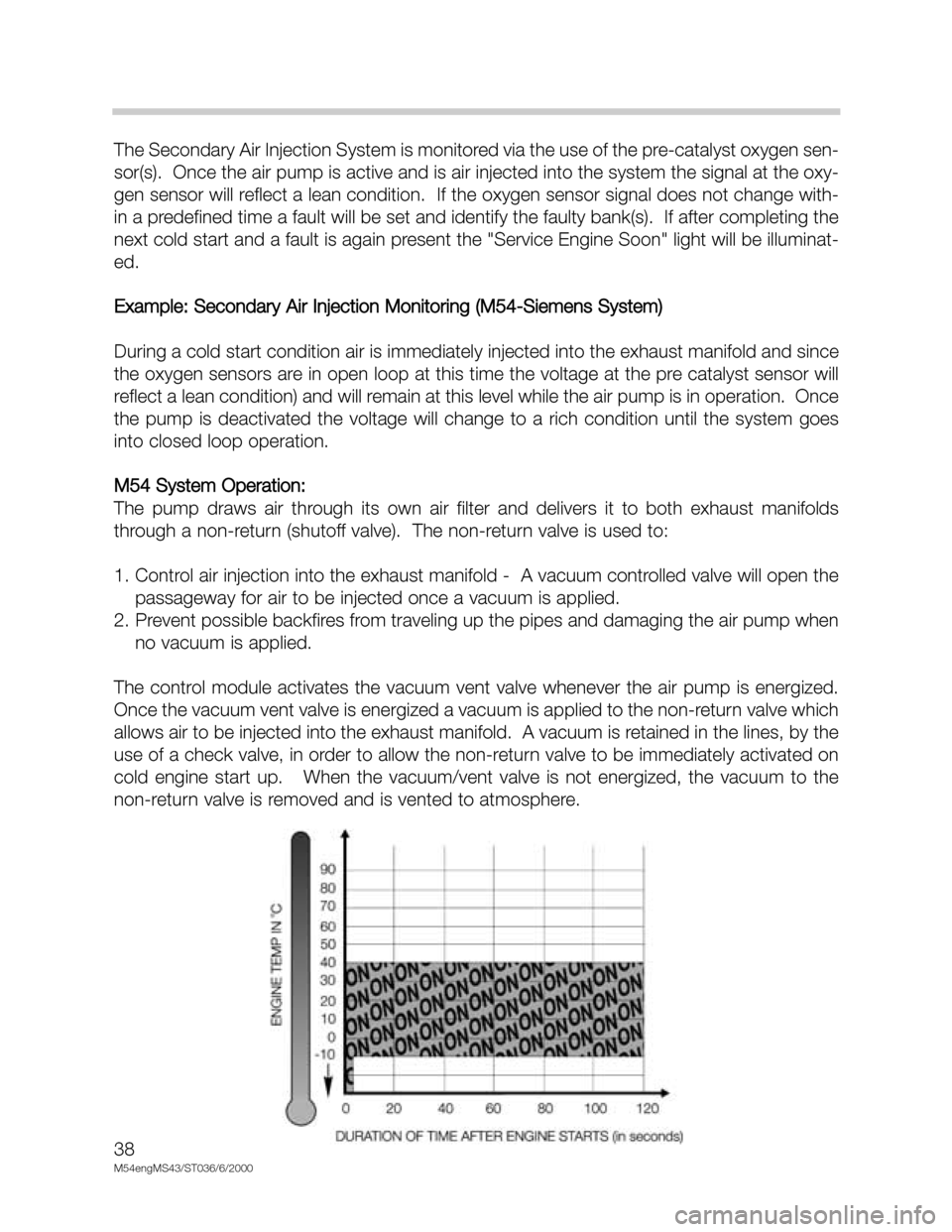
38
M54engMS43/ST036/6/2000
The Secondary Air Injection System is monitored via the use of the pre-catalyst oxygen sen-
sor(s). Once the air pump is active and is air injected into the system the signal at the oxy-
gen sensor will reflect a lean condition. If the oxygen sensor signal does not change with-
in a predefined time a fault will be set and identify the faulty bank(s). If after completing the
next cold start and a fault is again present the "Service Engine Soon" light will be illuminat-
ed.
Example: Secondary Air Injection Monitoring (M54-Siemens System)
During a cold start condition air is immediately injected into the exhaust manifold and since
the oxygen sensors are in open loop at this time the voltage at the pre catalyst sensor will
reflect a lean condition) and will remain at this level while the air pump is in operation. Once
the pump is deactivated the voltage will change to a rich condition until the system goes
into closed loop operation.
M54 System Operation:
The pump draws air through its own air filter and delivers it to both exhaust manifolds
through a non-return (shutoff valve). The non-return valve is used to:
1. Control air injection into the exhaust manifold - A vacuum controlled valve will open the
passageway for air to be injected once a vacuum is applied.
2. Prevent possible backfires from traveling up the pipes and damaging the air pump when
no vacuum is applied.
The control module activates the vacuum vent valve whenever the air pump is energized.
Once the vacuum vent valve is energized a vacuum is applied to the non-return valve which
allows air to be injected into the exhaust manifold. A vacuum is retained in the lines, by the
use of a check valve, in order to allow the non-return valve to be immediately activated on
cold engine start up. When the vacuum/vent valve is not energized, the vacuum to the
non-return valve is removed and is vented to atmosphere.
Page 45 of 48
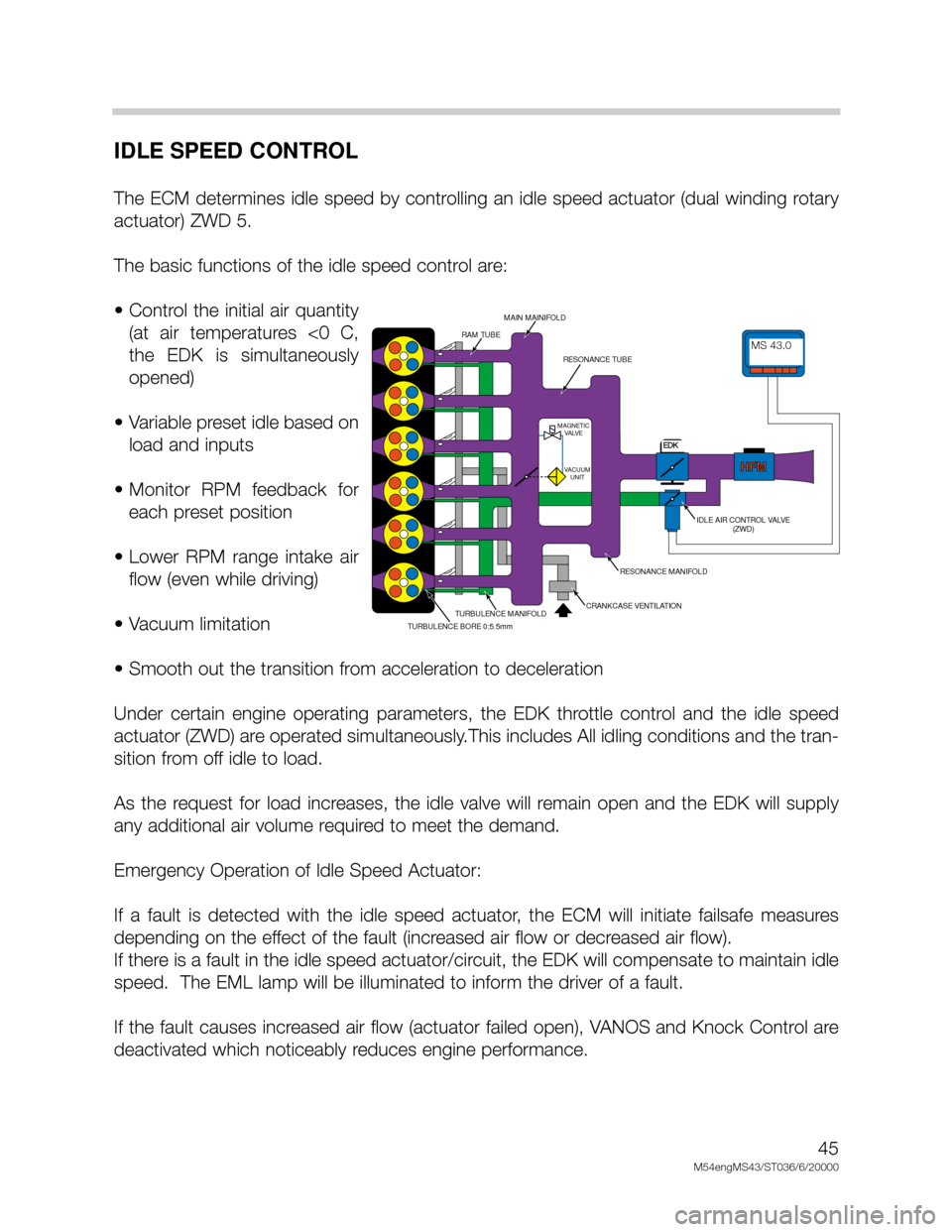
45
M54engMS43/ST036/6/20000
IDLE SPEED CONTROL
The ECM determines idle speed by controlling an idle speed actuator (dual winding rotary
actuator) ZWD 5.
The basic functions of the idle speed control are:
• Control the initial air quantity
(at air temperatures <0 C,
the EDK is simultaneously
opened)
• Variable preset idle based on
load and inputs
• Monitor RPM feedback for
each preset position
• Lower RPM range intake air
flow (even while driving)
• Vacuum limitation
• Smooth out the transition from acceleration to deceleration
Under certain engine operating parameters, the EDK throttle control and the idle speed
actuator (ZWD) are operated simultaneously.This includes All idling conditions and the tran-
sition from off idle to load.
As the request for load increases, the idle valve will remain open and the EDK will supply
any additional air volume required to meet the demand.
Emergency Operation of Idle Speed Actuator:
If a fault is detected with the idle speed actuator, the ECM will initiate failsafe measures
depending on the effect of the fault (increased air flow or decreased air flow).
If there is a fault in the idle speed actuator/circuit, the EDK will compensate to maintain idle
speed. The EML lamp will be illuminated to inform the driver of a fault.
If the fault causes increased air flow (actuator failed open), VANOS and Knock Control are
deactivated which noticeably reduces engine performance.
MDK
HFMHFM
MAGNETIC
VALVE
VACUUM
UNIT
MS42.0MS42.0
RAM TUBE
MAIN MAINIFOLD
RESONANCE TUBE
IDLE AIR CONTROL VALVE
(ZWD)
RESONANCE MANIFOLD
CRANKCASE VENTILATIONTURBULENCE MANIFOLD
TURBULENCE BORE 0:5.5mm
MS 43.0
EDK